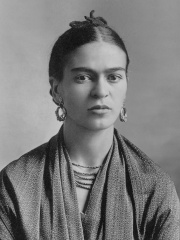
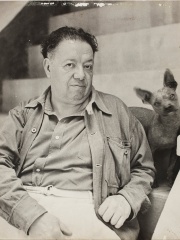
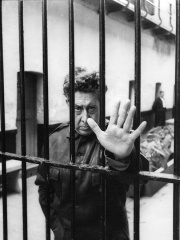
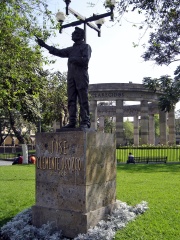
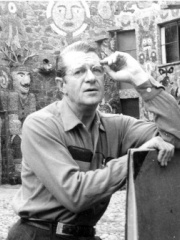

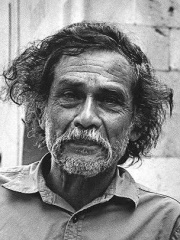

The Most Famous
PAINTERS from Mexico
Top 9
The following people are considered by Pantheon to be the most legendary Mexican Painters of all time. This list of famous Mexican Painters is sorted by HPI (Historical Popularity Index), a metric that aggregates information on a biography's online popularity.

1. Frida Kahlo (1907 - 1954)
With an HPI of 89.13, Frida Kahlo is the most famous Mexican Painter. Her biography has been translated into 166 different languages on wikipedia.
Magdalena Carmen Frida Kahlo y Calderón (Spanish pronunciation: [ˈfɾiða ˈkalo]; 6 July 1907 – 13 July 1954) was a Mexican painter known for her many portraits, self-portraits, and works inspired by the nature and artifacts of Mexico. Inspired by the country's popular culture, she employed a naïve folk art style to explore questions of identity, postcolonialism, gender, class, and race in Mexican society. Her paintings often had strong autobiographical elements and mixed realism with fantasy. In addition to belonging to the post-revolutionary Mexicayotl movement, which sought to define a Mexican identity, Kahlo has been described as a surrealist or magical realist. She is also known for painting about her experience of chronic pain. Her 1940 self-portrait titled The Dream (The Bed) holds the record for the most expensive work by a female artist ever auctioned at $54.7 million. Born to a German father and a mestiza mother (of Purépecha descent), Kahlo spent most of her childhood and adult life at La Casa Azul, her family home in Coyoacán – now publicly accessible as the Frida Kahlo Museum. Although she was disabled by polio as a child, Kahlo had been a promising student headed for medical school until being injured in a bus accident at the age of 18, which caused her lifelong pain and medical problems. During her recovery, she returned to her childhood interest in art with the idea of becoming an artist. Kahlo's interests in politics and art led her to join the Mexican Communist Party in 1927, through which she met fellow Mexican artist Diego Rivera. The couple married in 1929 and spent the late 1920s and early 1930s travelling together in Mexico and the United States. During this time, she developed her artistic style, drawing her main inspiration from Mexican folk culture, and painted mostly small self-portraits that mixed elements from pre-Columbian and Catholic beliefs. Her paintings raised the interest of surrealist artist André Breton, who arranged for Kahlo's first solo exhibition at the Julien Levy Gallery in New York in 1938; the exhibition was a success and was followed by another in Paris in 1939. While the French exhibition was less successful, the Louvre purchased a painting from Kahlo, The Frame, making her the first Mexican artist to be featured in their collection. Throughout the 1940s, Kahlo participated in exhibitions in Mexico and the United States and worked as an art teacher. She taught at the Escuela Nacional de Pintura, Escultura y Grabado ("La Esmeralda") and was a founding member of the Seminario de Cultura Mexicana. Kahlo's always-fragile health began to decline in the same decade. While she had had solo exhibitions elsewhere, she had her first solo exhibition in Mexico in 1953, shortly before her death in 1954 at the age of 47. Kahlo's work as an artist remained relatively unknown until the late 1970s, when her work was rediscovered by art historians and political activists. By the early 1990s, not only had she become a recognized figure in art history, but she was also regarded as an icon for Chicanos, the feminism movement, and the LGBTQ+ community. Kahlo's work has been celebrated internationally as emblematic of Mexican national and Indigenous traditions and by feminists for what is seen as its uncompromising depiction of the female experience and form.

2. Diego Rivera (1886 - 1957)
With an HPI of 79.33, Diego Rivera is the 2nd most famous Mexican Painter. His biography has been translated into 76 different languages.
Diego María de la Concepción Juan Nepomuceno Estanislao de la Rivera y Barrientos Acosta y Rodríguez (Spanish pronunciation: [ˈdjeɣo riˈβeɾa]; December 8, 1886 – November 24, 1957) was a Mexican painter. His large frescoes helped establish the mural movement in Mexican and international art. Between 1922 and 1953, Rivera painted murals in, among other places, Mexico City, Chapingo, and Cuernavaca, Mexico; and San Francisco, Detroit, and New York City. In 1931, a retrospective exhibition of his works was held at the Museum of Modern Art in Manhattan, shortly before Rivera's commencement of his 27-mural series known as Detroit Industry Murals the next year. Rivera had four wives and numerous children, including at least one illegitimate daughter. His first child and only son died at the age of two. His third wife was fellow Mexican artist Frida Kahlo, with whom he had a volatile relationship that continued until her death. His previous two marriages, ending in divorce, were respectively to a fellow artist and a novelist, and his final marriage was to his agent. Due to his importance in the country's art history, the government of Mexico declared Rivera's works as monumentos históricos. Rivera holds the record for highest price at auction for a work by a Latin American artist. The 1931 painting The Rivals, part of the record-setting collection of Peggy Rockefeller and David Rockefeller, sold for US$9.76 million at a 2018 Christie's auction.

3. David Alfaro Siqueiros (1896 - 1974)
With an HPI of 68.28, David Alfaro Siqueiros is the 3rd most famous Mexican Painter. His biography has been translated into 43 different languages.
David Alfaro Siqueiros (born José de Jesús Alfaro Siqueiros; December 29, 1896 – January 6, 1974) was a Mexican social realist painter, best known for his large public murals using the latest in equipment, materials and technique. Along with Diego Rivera and José Clemente Orozco, he was one of the most famous of the "Mexican muralists". Siqueiros was a member of the Mexican Communist Party. Although he went to Spain to support the Spanish Republic against the forces of Francisco Franco with his art, he volunteered and served in frontline combat as a Lieutenant Colonel in the Army of the Republic through 1938 before returning to Mexico City. In 1940, he led a failed assassination attempt on Leon Trotsky in which Trotsky's 14-year-old grandson was shot and American communist Robert Sheldon Harte was executed. After spending several months on the run from Mexican authorities disguised as a peasant, Siqueiros was eventually apprehended in Jalisco, although he was freed shortly thereafter and never brought to trial. By accordance with Spanish naming customs, his surname would normally have been Alfaro; however, like Picasso (Pablo Ruiz y Picasso) and Lorca (Federico García Lorca), Siqueiros used his mother's surname. It was long believed that he was born in Camargo in Chihuahua state, but in 2003 it was proven that he was born in the city of Chihuahua after the discovery of his birth certificate, but grew up in Irapuato, Guanajuato, at least from the age of six. According to Victor Mendoza Magallanes, he was born in Santa Rosalia in modern-day Camargo, Chihuahua. One source says that the discovery of his birth certificate in 2003 was by a Mexican art curator the following year by art critic Raquel Tibol, who was renowned as the leading authority on Mexican Muralism and who had been a close acquaintance of Siqueiros, although there hasn't been any evidence to prove this. Siqueiros changed his given name to "David" after his first wife called him by it in allusion to Michelangelo's David.

4. José Clemente Orozco (1883 - 1949)
With an HPI of 65.88, José Clemente Orozco is the 4th most famous Mexican Painter. His biography has been translated into 40 different languages.
José Clemente Orozco (November 23, 1883 – September 7, 1949) was a Mexican caricaturist and painter, who specialized in political murals that established the Mexican Mural Renaissance together with murals by Diego Rivera, David Alfaro Siqueiros, and others. Orozco was the most complex of the Mexican muralists, fond of the theme of human suffering, but less realistic and more fascinated by machines than Rivera. Mostly influenced by Symbolism, he was also a genre painter and lithographer. Between 1922 and 1948, Orozco painted murals in Mexico City; Orizaba; Claremont, California; New York City; Hanover, New Hampshire; Guadalajara, Jalisco; and Jiquilpan, Michoacán.
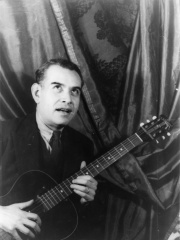
5. Rufino Tamayo (1899 - 1991)
With an HPI of 60.73, Rufino Tamayo is the 5th most famous Mexican Painter. His biography has been translated into 24 different languages.
Rufino del Carmen Arellanes Tamayo (August 25, 1899 – June 24, 1991) was a Mexican painter of Zapotec heritage, born in Oaxaca de Juárez, Mexico. Tamayo was active in the mid-20th century in Mexico and New York, painting figurative abstraction with surrealist influences.

6. Juan O'Gorman (1905 - 1982)
With an HPI of 57.38, Juan O'Gorman is the 6th most famous Mexican Painter. His biography has been translated into 20 different languages.
Juan O'Gorman (6 July 1905 – 17 January 1982) was a Mexican painter and architect.

7. Emmanuel Lubezki (b. 1964)
With an HPI of 55.95, Emmanuel Lubezki is the 7th most famous Mexican Painter. His biography has been translated into 33 different languages.
Emmanuel Lubezki Morgenstern (Spanish pronunciation: [emaˈnwel luˈβeski]; born November 30, 1964) is a Mexican cinematographer. Lubezki is known for uses of natural lighting and continuous uninterrupted shots in cinematography, often utilizing a Steadicam, a 3-axis gimbal, or hand-held camera. He is also known for his frequent collaborations with Terrence Malick, Alfonso Cuarón, and Alejandro González Iñárritu. He has received numerous accolades including three consecutive wins for the Academy Award for Best Cinematography for the science fiction thriller Gravity (2013), the dark comedy Birdman (2014), and the epic western The Revenant (2015). He was Oscar-nominated for his work on A Little Princess (1995), Sleepy Hollow (1999), The New World (2005), Children of Men (2006), and The Tree of Life (2011). Lubezki is a member of both the Mexican Society of Cinematographers and the American Society of Cinematographers. Lubezki won the Royal Photographic Society Lumière Award for major achievement in cinematography, video or animation in 2016.

8. Francisco Toledo (1940 - 2019)
With an HPI of 54.41, Francisco Toledo is the 8th most famous Mexican Painter. His biography has been translated into 17 different languages.
Francisco Benjamín López Toledo (17 July 1940 – 5 September 2019) was a Mexican painter, sculptor, and graphic artist. In a career that spanned seven decades, Toledo produced thousands of works of art and became widely regarded as one of Mexico's most important contemporary artists. An activist as well as an artist, he promoted the artistic culture and heritage of Oaxaca state. Toledo was considered part of the Breakaway Generation of Mexican art.

9. Ignacio Ortiz (b. 1934)
With an HPI of 9.12, Ignacio Ortiz is the 9th most famous Mexican Painter. His biography has been translated into 1 different languages.
IGNACIO ORTIZ CEDEÑO Originally from La Piedad, Michoacán, he was born in 1934. He completed his first professional studies at the University of Nuevo León at the Plastic Arts Workshop, and continued his studies at the INBA School of Painting. "The Emerald". He was from the generation of artists of the second half of the 20th century, a contemporary and friend of Francisco Corzas, Óscar Rodríguez, Pedro Freideberg, Francisco Icaza, Arnold Belkin, Jorge Alsaga, Roberto Donis, Mario Orozco Rivera and Rodolfo Nieto, almost all of them trained . In his first stage at the universities of Mexico, in 1954 he was recommended by Diego Rivera, David Alfaro Siqueiros and Pablo O'Higgins, who recognized his talent and dedication. He completed a postgraduate study at the School of Plastic Arts in Prague (Czechoslovakia), exhibited at the “Umprum” gallery in Prague, in Bratislava (Slovakia), in Sofia (Bulgaria), at the “Le France” gallery (Paris, France ). ) among other. Upon his return to Mexico, he reorganized the Plastic Arts workshop at the University of Nuevo León, was named its director, held various exhibitions throughout the country and was named director of the “El Caracol” Art Center. In 1966 he moved to Xalapa (Veracruz) where he reorganized the Plastic Arts Workshop of the Universidad Veracruzana and was appointed director. In 1968 he completed a doctorate in Art History in Uppsala (Sweden), and was named an honorary member of the Royal Union of Swedish Painters. Museums and galleries in Europe begin to exhibit his work, and in different media they refer to the subtle forms and abstraction that he uses through geometric figures, giving shape to faces, mostly female, and figures that flaunt his playful capacity, the poetic construction through his strokes and the contrast in the characteristic colors of his work, calling him in the printed media as “El Mexicano”. Stockholm (Sweden), Liljevalch gallery (Uppsala) and the “Konsthall” gallery (Sweden) are settings where his work was exhibited. In 1971 he was invited by the painter Pablo Picasso to collaborate in his workshop in Vallauris (France). Upon his return to Mexico, he held a series of exhibitions that support more than sixty years of his career, he exhibited individually at Mary Moore Gallery (La Jolla, California), Museum of Contemporary Art (Morelia, Michoacán), Palacio de Bellas Artes (CDMX), Casa of Culture (Oaxaca, Mexico), Municipal Palace (Monterrey, NL.). and privately for a group of collectors from the Televisa company, he exhibits again in Sweden (Umprum gallery), in CDMX (Soutine gallery), “Enrique Jiménez” gallery (CDMX), Arte A. C. gallery in Monterrey, Centro Financiero Bancomer , Cervantino International Festival in Guanajuato, Salón de la Plástica Mexicana, Pinacoteca de Nuevo León, Secretariat of the Interior, Exhibition Hall of the CDMX International Airport, collective Pinacoteca NL Collection, Donceles 66 Cultural Center, Historical Center, CDMX Industrial Club, Casa de the Tlalpan Culture During his career he received various awards and recognitions, including: from the Salón de Noviembre en Arte A.C, “Miró" drawing award (Barcelona, Spain), from the Government of Nuevo León, Secretariat of Education and Culture for his collaboration in Nuevo Leon art, diploma from the Autonomous University of Nuevo León, in recognition of his arduous artistic career, recognition granted by the Metropolitan Museum of Monterrey and he was named a member of the Salón de la Plástica Mexicana. His work appears published in several magazines and books, the most recent publication is the book “Dialogue between poetry and painting” Pita Amor/Ignacio Ortiz, written in 2019 by his widow and representative Michelle Sandiel IGNACIO ORTIZ CEDEÑO Originario de la Piedad, Michoacán nace en 1934, realizó sus primeros estudios profesionales en la Universidad de Nuevo León en el Taller de Artes Plásticas, continuó sus estudios en la escuela de Pintura del INBA. “La Esmeralda”. Fue de la generación de artistas de la segunda mitad del siglo XX, contemporáneo y amigo de Francisco Corzas, Óscar Rodríguez, Pedro Freideberg, Francisco Icaza, Arnold Belkin, Jorge Alsaga, Roberto Donis, Mario Orozco Rivera y Rodolfo Nieto, formados casi todos ellos en su primera etapa en las universidades de México, en 1954 fue recomendado por Diego Rivera, David Alfaro Siqueiros y Pablo O’Higgins, quienes le reconocieron su talento y dedicación. Realizó un estudio de postgrado en la Escuela de Artes Plásticas de Praga (Checoslovaquia), expuso en la galería “Umprum” en Praga, en Bratislava (Eslovaquia), en Sofía (Bulgaria), en la galería “Le France” (París, Francia) entre otras. A su regreso a México, reorganiza el taller de Artes Plásticas de la Universidad de Nuevo León, fue nombrado director del mismo, realizó diversas exposiciones a lo largo del país y nombrado director del Centro de Arte “El Caracol”. En 1966 se trasladó a Xalapa (Veracruz) donde reorganizó el Taller de Artes Plásticas de la Universidad Veracruzana y fue nombrado director. Realizó en 1968 un doctorado en Historia del Arte en Uppsala (Suecia), fue nombrado miembro honorario de la Unión Real de Pintores Suecos. Los museos y galerías en Europa comienzan a exhibir su obra, y en distintos medios de comunicación hacen referencia a las formas sutiles y la abstracción que emplea por medio de figuras geométricas, dando forma a rostros, en su mayoría femeninos y figuras que hacen alarde de su capacidad lúdica, la construcción poética por medio de sus trazos y el contraste en el colorido característico de su obra, llamándolo en los medios impresos como “El Mexicano”. Estocolmo (Suecia), galería Liljevalch (Uppsala) y la galería “Konsthall” (Suecia) son escenarios donde se exhibió su obra. En 1971 fue invitado por el pintor Pablo Picasso para colaborar en su taller en Vallauris (Francia). A su regreso a México realizó una serie de exposiciones que avalan más de sesenta años de su trayectoria, expuso individualmente en Mary Moore Gallery (La Jolla, California) Museo de Arte Contemporáneo (Morelia, Michoacán) Palacio de Bellas Artes (CDMX), Casa de la Cultura (Oaxaca, México), Palacio Municipal (Monterrey, NL.). y de manera privada para un grupo de coleccionistas de la empresa Televisa, expone nuevamente en Suecia,(galería Umprum), en la CDMX (galería Soutine), galería “Enrique Jiménez” (CDMX), galería Arte A. C. en Monterrey, Centro Financiero Bancomer, Festival Internacional Cervantino en Guanajuato, Salón de la Plástica Mexicana, Pinacoteca de Nuevo León, Secretaría de Gobernación, Sala de Exhibiciones del Aeropuerto Internacional CDMX, colectiva Colección Pinacoteca NL, Centro Cultural Donceles 66, Centro Histórico, Club de Industriales CDMX, Casa de la Cultura Tlalpan Durante su trayectoria recibió diversos premios y reconocimientos entre ellos: del Salón de Noviembre en Arte A.C, premio de dibujo “Miró" (Barcelona, España), del Gobierno de Nuevo León Secretaría de Educación y Cultura por su colaboración en la plástica nuevoleonesa, diploma de la Universidad Autónoma de Nuevo León, en reconocimiento por su ardua trayectoria artística, reconocimiento otorgado por el Museo Metropolitano de Monterrey y fue nombrado miembro del Salón de la Plástica Mexicana. Su obra aparece publicada en varias revistas y libros, la publicación más reciente es el libro “Diálogo entre poesía y pintura” Pita Amor/Ignacio Ortiz, escrito en 2019 por su viuda y representante Michelle Sandiel.
People
Pantheon has 9 people classified as Mexican painters born between 1883 and 1964. Of these 9, 2 (22.22%) of them are still alive today. The most famous living Mexican painters include Emmanuel Lubezki, and Ignacio Ortiz. The most famous deceased Mexican painters include Frida Kahlo, Diego Rivera, and David Alfaro Siqueiros.
Living Mexican Painters
Go to all RankingsDeceased Mexican Painters
Go to all RankingsFrida Kahlo
1907 - 1954
HPI: 89.13
Diego Rivera
1886 - 1957
HPI: 79.33
David Alfaro Siqueiros
1896 - 1974
HPI: 68.28
José Clemente Orozco
1883 - 1949
HPI: 65.88
Rufino Tamayo
1899 - 1991
HPI: 60.73
Juan O'Gorman
1905 - 1982
HPI: 57.38
Francisco Toledo
1940 - 2019
HPI: 54.41
Overlapping Lives
Which Painters were alive at the same time? This visualization shows the lifespans of the 7 most globally memorable Painters since 1700.

